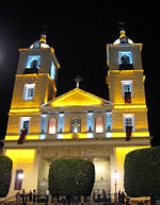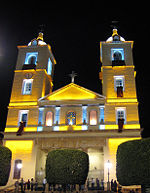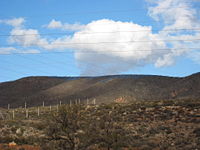
Berja
Encyclopedia
Berja is a municipality
Municipality
A municipality is essentially an urban administrative division having corporate status and usually powers of self-government. It can also be used to mean the governing body of a municipality. A municipality is a general-purpose administrative subdivision, as opposed to a special-purpose district...
of Almería province
Almería (province)
-History:The rich customs and Fiestas of the denizens retain links deep into the past, unto the Moors, the Romans, the Greeks, and the Phoenicians.During the taifa era, it was ruled by the Moor Banu al-Amiri from 1012 to 1038, briefly annexed by Valencia , then given by Zaragoza to the Banu Sumadih...
, in the autonomous community of Andalusia
Andalusia
Andalusia is the most populous and the second largest in area of the autonomous communities of Spain. The Andalusian autonomous community is officially recognised as a nationality of Spain. The territory is divided into eight provinces: Huelva, Seville, Cádiz, Córdoba, Málaga, Jaén, Granada and...
, Spain
Spain
Spain , officially the Kingdom of Spain languages]] under the European Charter for Regional or Minority Languages. In each of these, Spain's official name is as follows:;;;;;;), is a country and member state of the European Union located in southwestern Europe on the Iberian Peninsula...
. It is located on the south-eastern slope of the Sierra de Gádor, 10 miles north-east of Adra
Adra, Spain
-Culture in Adra:Adra Museum, Visitors can spend their free time in the three exhibition halls of the museum, which show the cultural legacy of the Phoenician, Punic and Roman civilizations, and which educate and entertain at the same time. Important exhibitions of national prestige are...
by road.
History

Berja may have Phoenicia
Phoenicia
Phoenicia , was an ancient civilization in Canaan which covered most of the western, coastal part of the Fertile Crescent. Several major Phoenician cities were built on the coastline of the Mediterranean. It was an enterprising maritime trading culture that spread across the Mediterranean from 1550...
n or Iberian
Iberians
The Iberians were a set of peoples that Greek and Roman sources identified with that name in the eastern and southern coasts of the Iberian peninsula at least from the 6th century BC...
origins; it was known to the Romans
Roman Empire
The Roman Empire was the post-Republican period of the ancient Roman civilization, characterised by an autocratic form of government and large territorial holdings in Europe and around the Mediterranean....
as Vergis or Vergium, and it was part of the province of Baetica. There are Roman remains in the Villa Vieja: an amphitheater and an aqueduct
Aqueduct
An aqueduct is a water supply or navigable channel constructed to convey water. In modern engineering, the term is used for any system of pipes, ditches, canals, tunnels, and other structures used for this purpose....
, and mosaics whose style and production are similar to those found in Pompeii
Pompeii
The city of Pompeii is a partially buried Roman town-city near modern Naples in the Italian region of Campania, in the territory of the comune of Pompei. Along with Herculaneum, Pompeii was destroyed and completely buried during a long catastrophic eruption of the volcano Mount Vesuvius spanning...
and Herculaneum
Herculaneum
Herculaneum was an ancient Roman town destroyed by volcanic pyroclastic flows in AD 79, located in the territory of the current commune of Ercolano, in the Italian region of Campania in the shadow of Mt...
.
Saint Ctesiphon (San Tesifón), patron saint
Patron saint
A patron saint is a saint who is regarded as the intercessor and advocate in heaven of a nation, place, craft, activity, class, clan, family, or person...
of the town, is said to have preached in the area in the first century, bringing Christianity
Christianity
Christianity is a monotheistic religion based on the life and teachings of Jesus as presented in canonical gospels and other New Testament writings...
to the town. From this era are conserved coins, crosses, and a sarcophagus
Sarcophagus
A sarcophagus is a funeral receptacle for a corpse, most commonly carved or cut from stone. The word "sarcophagus" comes from the Greek σαρξ sarx meaning "flesh", and φαγειν phagein meaning "to eat", hence sarkophagus means "flesh-eating"; from the phrase lithos sarkophagos...
found in the neighborhood of Alcaudique, which is now found in the National Archaeological Museum (Museo Arqueológico Nacional). A reproduction exists in the Museum of Almería
Almería
Almería is a city in Andalusia, Spain, on the Mediterranean Sea. It is the capital of the province of the same name.-Toponym:Tradition says that the name Almería stems from the Arabic المرية Al-Mariyya: "The Mirror", comparing it to "The Mirror of the Sea"...
.
The site suffered an earthquake
Earthquake
An earthquake is the result of a sudden release of energy in the Earth's crust that creates seismic waves. The seismicity, seismism or seismic activity of an area refers to the frequency, type and size of earthquakes experienced over a period of time...
in the fifth century, and the Roman town subsequently dissolved into various smaller communities, one of which –Berja- became the dominant one. After the Moorish
Moors
The description Moors has referred to several historic and modern populations of the Maghreb region who are predominately of Berber and Arab descent. They came to conquer and rule the Iberian Peninsula for nearly 800 years. At that time they were Muslim, although earlier the people had followed...
invasion of Iberia in the eighth century, the town was known as Berchat, and a fortress was built in the town. Remains of Moorish baths can still be seen in the neighborhood of Benejí.
It was occupied by Christian forces in 1489 during the Reconquista
Reconquista
The Reconquista was a period of almost 800 years in the Middle Ages during which several Christian kingdoms succeeded in retaking the Muslim-controlled areas of the Iberian Peninsula broadly known as Al-Andalus...
. The Morisco Revolt
Morisco Revolt
The Morisco Revolt , also known as War of Las Alpujarras or Revolt of Las Alpujarras, in what is now Andalusia in southern Spain, was a rebellion against the Crown of Castile by the remaining Muslim converts to Christianity from the Kingdom of Granada.-The defeat of Muslim Spain:In the wake of the...
in 1568 led to many deaths in Berja, which was nearly depopulated after the end of the uprising. In autumn of 1588 two hermits arrived in Berja named Domingo de San Juan and Juan de Santa María, who founded in the depopulated area of Pixnela the sanctuary dedicated to a patroness of Berja: the Virgin of Gádor (Virgen de Gádor).
Berja would be administered from Ugíjar
Ugíjar
Ugíjar is a municipality located in the province of Granada, Spain. According to the 2005 census , the city has a population of 2524 inhabitants....
until October 29, 1753, when it was allowed to have its own mayor, forming part of the administrative area of Las Alpujarras, within the old kingdom of Granada. On August 25, 1804, another earthquake destroyed much of the town. Under the regency of Maria Christina
Maria Christina of Austria
Maria Christina of Austria was Queen consort of Spain as the second wife of King Alfonso XII of Spain...
, Javier de Burgos
Javier de Burgos
Francisco Javier de Burgos y del Olmo was a Spanish jurist, politician, journalist, and translator.-Early life and career:...
used his influence to turn Spain's antiquated administrative system into a provincial one
1833 territorial division of Spain
The 1833 territorial division of Spain divided Spain into provinces, classified into "historic regions" . on the official web site of the government of the Canary Islands, accessed 2009-12-31...
, advocating the need for a centralized government
Centralized government
A centralized or centralised government is one in which power or legal authority is exerted or coordinated by a de facto political executive to which federal states, local authorities, and smaller units are considered subject...
. In 1833, Las Alpujarras was divided into two zones: one remained part of the province of Granada, the other was part of the province of Almería
Almería (province)
-History:The rich customs and Fiestas of the denizens retain links deep into the past, unto the Moors, the Romans, the Greeks, and the Phoenicians.During the taifa era, it was ruled by the Moor Banu al-Amiri from 1012 to 1038, briefly annexed by Valencia , then given by Zaragoza to the Banu Sumadih...
. Berja fell within the second province.
Exploitation of the lead mines in Berja began in the 19th century, and the city consequently flourished during this time.
Economy

Lead
Lead is a main-group element in the carbon group with the symbol Pb and atomic number 82. Lead is a soft, malleable poor metal. It is also counted as one of the heavy metals. Metallic lead has a bluish-white color after being freshly cut, but it soon tarnishes to a dull grayish color when exposed...
mines, but these are now closed. From the 16th century, the city began production of a wine whose cultivation was commercialized in the 19th century under the brand name “Salobra.” The city has a solar plant that was opened on December 12, 2007. It is found on the peak of the mountain Montivel.
Climate
The climate of Berja has one of the sunniest, warmest and driest climates in Europe. It's located in a Semi- Arid climate zone. On July 18, 1978 the highest official recorded temperature in Berja was 50.0 °C which is also the highest reliable temperature recorded in Spain during standard conditions.External links
Official website- Berja - Sistema de Información Multiterritorial de Andalucía Berja - Diputación Provincial de Almería
- Patronato municipal de deportes de Berja

